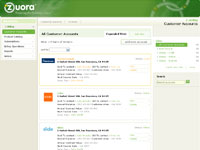
Software as a Service has become the business and software delivery model of choice among new vendors — not to mention companies seeking to invest in IT. Surprisingly, considering the model’s growing market share, few companies have sprung up to offer SaaS applications for the providers themselves.
Enter Zuora. Not quite a year old, it can count itself among the first vendors to target the back-end needs of SaaS companies, Denis Pombriant, principal of Beagle Research, told CRM Buyer.
Zuora made its official debut in May 2008 with an online billing application for SaaS providers. It has since introduced payment and sales applications, and, most recently, a cloud computing play targeting the e-commerce space.
This year, the company plans to introduce another three to five applications, Zuora CEO Tien Tzuo told CRM Buyer. From there, who knows?
Tzuo, who previously held executive positions with both Salesforce.com and Oracle, sees unlimited demand for Zuora’s applications.
“Everything is moving to a subscription-based model — not just software,” he said, pointing to companies like Netflix and Zipcar as examples.
Certainly, its own growth points to pent-up demand. Since its launch, Zuora has signed on about 80 clients — including 10 since the beginning of 2009.
How It Works
With some US$21.5 million in capital funding under its belt, Zuora introduced its first app: Z-Billing. It picked this particular category because billing — as any cable company could tell you — can be a difficult nut to crack for even well-established companies, much less start up SaaS firms.
Offering a billing app first was a smart move for the company, Beagle’s Pombriant said. “Especially in the SaaS space, it can be very difficult to build a back-end billing application. I have heard horror stories from other SaaS vendors about this piece of their operations.”
Traditionally, billing applications do not scale the way a SaaS vendor adds clients, Tzuo explained, which is usually on a seat-by-seat basis. Also, SaaS companies tend to offer many different variations of their products, making billing even more complex.
Developed with these issues in mind, Z-Billing can support just about any pricing model a SaaS vendor develops for its products, including one-time, recurring, usage and metering charges, as well as volume tier pricing. It also maintains a single system for customer subscriptions and invoices. Other features include audit-history and compliance tracking.
Shortly the launch of Z-Billing, the company introduced Z-Payments, another application that focuses on a SaaS company’s back office operations. It allows users to receive, reconcile and manage recurring payments on any schedule — from daily, weekly, monthly or annually to one-off or ad hoc payments. It also allows a SaaS firm’s customers to make their payments through PayPal and Authorize.Net.
The third application introduced in 2008 was Z-Force, a sales application built on Salesforce.com’s Force.com platform. You have to be a Salesforce.com user to take advantage of this application. It integrates payment and billing information into Salesforce.com to help users develop a stronger sales pipeline, among other goals.
Earlier this month, Zuora rolled out an application that is something of a departure from its earliest endeavors: a cloud computing play tailored for e-commerce developers.
Cloud computing is clearly a high-growth category right now, Zuora’s Tzuo said, and the company wants to make sure it is able to make its own platform and toolsavailable to developers.
The business case matches Zuora’s original premise: Developers building in the cloud need to get paid, send out invoices, make sales and so on — just like their SaaS counterparts — and there are few if any applications addressing their needs.
Zuora’s Z-Commerce Platform gives developers access to Z-Billing, Z-Payments, and Z-Force’s API (application programming interface) documentation, sample code and toolkits. There is also a sandbox environment, Tzuo said — but it is available only in private beta right now.
“It’s still early days with this, and we want to make sure we can support everybody before we can open it to all developers,” said Tzuo.
In the Beginning
If Tzuo is appreciative of the risks of scaling up too quickly, that is because he has been there. One of the executives on board when Salesforce.com launched some 10 years ago, he has firsthand knowledge of the difficulties SaaS companies experience in building their own IT operations.
Indeed, the idea for the company was born at a meeting between Tzuo, Salesforce.com CEO Marc Benioff and WebEx founder K.V. Rao.
Salesforce.com and WebEx “realized they had a lot of shared experiences — shared pain — in building a SaaS company,” Tzuo said, starting with the fact the companies had spent millions developing back-end IT solutions that were customized for the SaaS model.
After the meeting, Tzuo became serious about the idea of building a company that would address this gap in the software market. Benioff, his boss at the time, encouraged him — and, in fact, invested in the company.
“We joke that Zuora is the love child of Salesforce.com and WebEx,” said Tzuo.
























































"Zuora is the love child of Webex and Salesforce???"
That’s pretty damn corny.